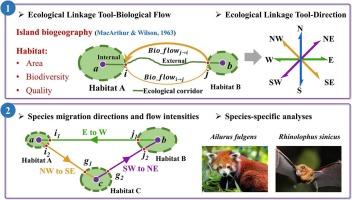从生态网络视角揭示中国东西部生物流动动态
IF 11.2
1区 社会学
Q1 ENVIRONMENTAL STUDIES
引用次数: 0
摘要
中国是生物多样性最丰富的国家之一,但由于地理障碍,东西部地区的生态差距限制了物种迁移,破坏了生态系统的连通性。然而,生物流动在弥合这一鸿沟方面的潜力仍然知之甚少。为了解决这一问题,我们开发了一个动态生物流框架,将生态网络与生态链接工具方向和生物流两个新工具相结合,量化了美丽中国中部脊椎的物种迁移方向和强度。在生态资源的内部和外部,我们分析了动态的生物流和网络结构在节点,链接和图的水平。我们还模拟了不同廊道和生境退化情景下网络效率的变化。在13800个生态廊道中,27%的廊道是东西向的,但该地区的净栖息地流入为负,48%的迁徙物种可能无法到达目标栖息地。生境外的生物流动遵循西向东(21%)和北向南(18%)的模式,北向南方向的迁移损失最大。区域网络效率为0.053。内蒙古牧区生态网络的失效使效率降低了24%,斑块内东西向廊道降低了57%,斑块间西向东廊道降低了13%。小熊猫(Ailurus fulgens)和中华马蹄蝠(Rhinolophus sinicus)的物种特异性分析表明,栖息地分布决定了动态流动方向,而物种特异性适应性影响了流动强度。该研究量化了动态生物流动模式,克服了广泛使用的基于静态分布的保护规划的局限性,更准确地反映了物种的迁移特征。本文章由计算机程序翻译,如有差异,请以英文原文为准。

Revealing the dynamic biological flow between eastern and western China from the perspective of ecological network
China is one of the most biodiversity-rich countries, yet the ecological gap between its eastern and western regions, driven by geographical barriers, restricts species migration and disrupts ecosystem connectivity. However, the potential of biological flow to bridge this divide remains poorly understood. To address this, we developed a dynamic biological flow framework, combining ecological networks with two new tools, Ecological Linkage Tool Direction and Biological Flow, to quantify species migration directions and intensities across the Middle Spine of Beautiful China. Within and beyond ecological sources, we analyze dynamic biological flow and network structure at node, link, and graph levels. We also simulate changes in network efficiency under various corridor and habitat degradation scenarios. Among the 13,800 ecological corridors, 27 % are oriented east-west (EW), yet the region exhibits a net negative habitat inflow, with 48 % of migrating species potentially failing to reach target habitats. Biological flows outside habitats follow west-to-east (21 %) and north-to-south (18 %) patterns, with the highest migration losses occurring in the north-to-south direction. The regional network efficiency is 0.053. The failure of ecological network in the Inner Mongolia Pastoral Area reduces efficiency by 24 %, intra-patch EW corridors by 57 %, and inter-patch west-to-east corridors by 13 %. Species-specific analyses of the red panda (Ailurus fulgens) and Chinese horseshoe bat (Rhinolophus sinicus) reveals that habitat distribution determines dynamic flow direction, while species-specific adaptability influences flow intensity. This study quantifies dynamic biological flow patterns, overcoming the limitations of widely used static distribution-based conservation planning, more accurately reflecting species migration traits.
求助全文
通过发布文献求助,成功后即可免费获取论文全文。
去求助
来源期刊

Environmental Impact Assessment Review
ENVIRONMENTAL STUDIES-
CiteScore
12.60
自引率
10.10%
发文量
200
审稿时长
33 days
期刊介绍:
Environmental Impact Assessment Review is an interdisciplinary journal that serves a global audience of practitioners, policymakers, and academics involved in assessing the environmental impact of policies, projects, processes, and products. The journal focuses on innovative theory and practice in environmental impact assessment (EIA). Papers are expected to present innovative ideas, be topical, and coherent. The journal emphasizes concepts, methods, techniques, approaches, and systems related to EIA theory and practice.
 求助内容:
求助内容: 应助结果提醒方式:
应助结果提醒方式:


